Spring Soundwalks with Students
On the campus of Ohio State University
This past spring, I once again found myself happily adapting my long-standing listening project called Forest Listening Rooms for a new audience. This time it was a special chance to work with several classes of high school students on soundwalks on Ohio State University’s campus. What a joy! Seriously, the students were curious, thoughtful, and kind. They were also willing to participate in the odd activity (for teenagers, at least) of being quiet and listening and walking.
These walks were sponsored by the Learning and Public Practice program at the Wexner Center for the Arts, and each was followed by a visit to the Wexner Center’s galleries.
I mentioned this in my last post, but will do so again: I’ve spent such a long time focusing on a particular place and community of people — in the Wayne National Forest in Appalachian Ohio. And as the Forest Listening Rooms project has grown and evolved, I’ve been approached several times to adapt it. This process has been so rewarding; I’ve been surprised at how wonderful the results have been in each new place and situation.
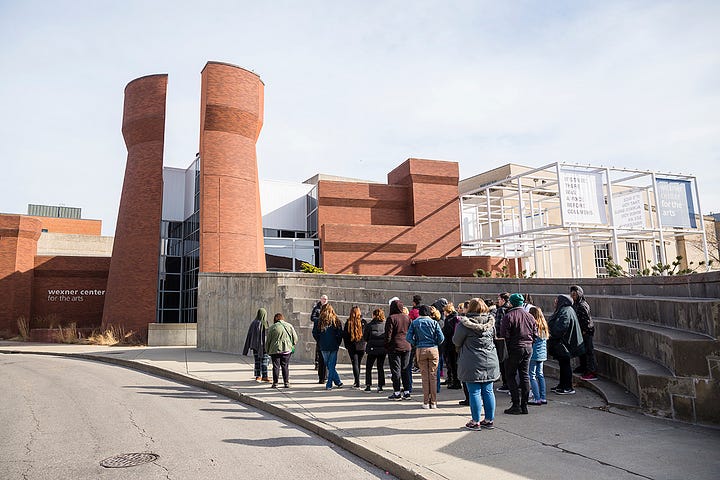
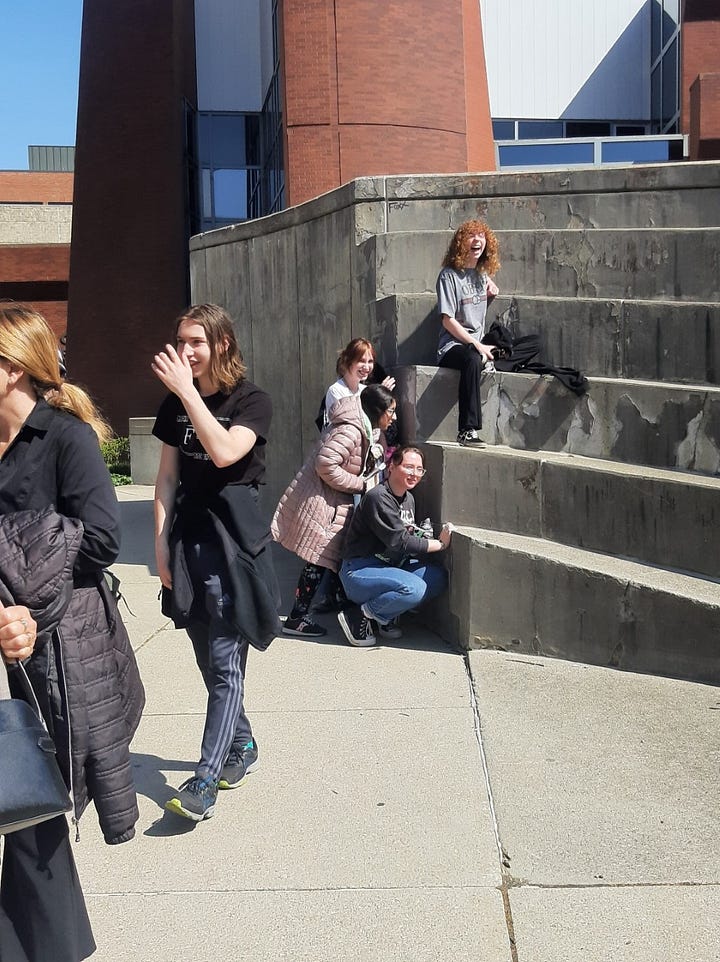
Here, the students met with me outside (at the appropriately named “Whispering Wall”). I shared with them a bit about myself and work, and then laid out the rules for our walk: no talking or phones (at first), be open and pay attention, and remember what you heard.
Even though we were in the middle of the city, I asked the students to imagine what this place might have been like only a couple of centuries earlier, when Ohio’s landscape was almost entirely an old growth forest, and where native peoples lived, traveled through, farmed, and hunted.
The themes of our walks — the environment/environmental justice, paying attention/mindfulness, and imagining the past/acknowledging indigenous people who were here — all connect directly with the current exhibitions at the Wexner Center for the Arts, including works of Anna Tsouhlarakis, A. K. Burns, Sa’dia Rehman, and Hope Ginsburg. The soundwalks complemented and amplified these works, giving the students opportunities to reflect on the themes from different perspectives.
The first walk was so unseasonably cold that I had to make it much shorter than intended. Against bitter winds and cold, we shuffled to nearby Mirror Lake. With each walk (and especially this one!) I was astonished to see how the students not only participated, but did so wholeheartedly. Here, they braved the cold as we stood by the lake and quietly listened to muted late-winter sounds fighting against new spring sounds around us: wind, snow crunching underfoot, chimes ringing, students scurrying across the paths, all against the arrival of new birds and fresh buds on the trees.
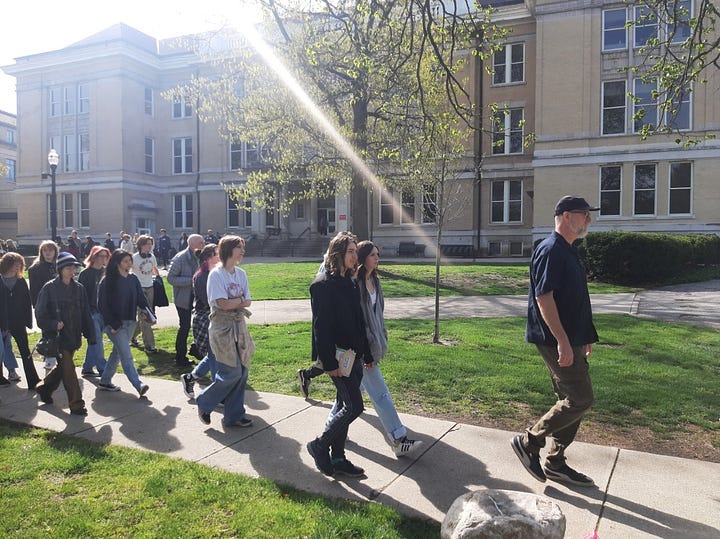

Subsequent soundwalks were much warmer, and each time spring made itself ever-more known. On these walks, we opted to travel across the oval and through a complex of athletic buildings and fields; then past a grove of buckeye trees, and finally we descended down a hill to the Olentangy River.
While at the river, we could see and hear glimmers of a wild land in front of us, even as we were surrounded by roads and traffic. The water rushed by, heavy from recent spring rain. After listening in silence together, I asked the students to imagine this entire area covered with old trees, and to imagine what it might have sounded like.
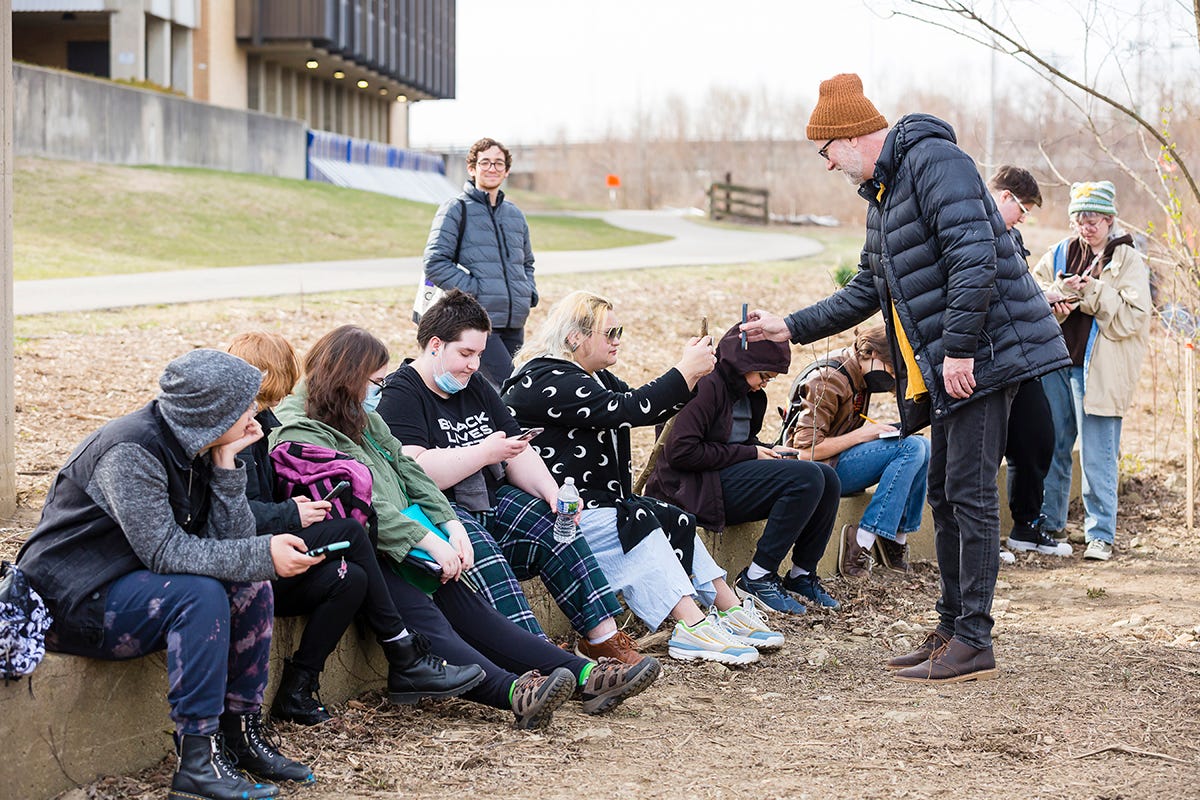
As an experiment, I had everyone take out their phones. I shared a QR code with them of a recording I made in the Wayne National Forest one morning in the spring a few years ago. I asked the students to turn up the volume and play the recording on their phones. As they did so, they created a canon of field recordings, and suddenly the air was filled with bird sounds of what it might have been like here centuries ago. It was fascinating to see the students' reactions at the difference between the two soundscapes, and to hear them together.
You can listen to my recording from Wildcat Hollow in the Wayne National Forest here:
After each listening session, we walked back to the Wexner Center. Throughout the years, I’ve loved this part of each walk: after being quiet and concentrating for so long, everyone begins to talk and connect, and it is a pleasure to hear their conversations. Back inside the galleries, the students explored each exhibit. I saw their curiosity and playfulness as they pieced together meanings and symbols, or sat among the screens of underwater seascapes.
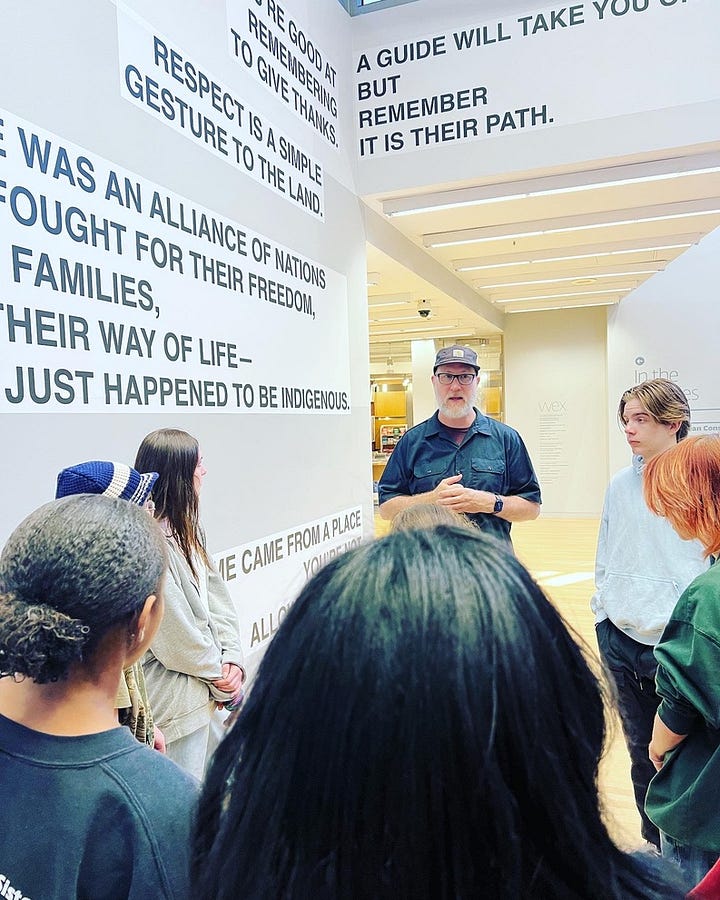

Finally, I thought I would share a few quotes from students about their experiences on the soundwalks. These students were all from Mosaic, a high school experiential learning program in Columbus, Ohio.
“I enjoyed the walk so much because it was about very intentional listening and it was organized by a soundscape artist. I appreciated Brian’s approach to explaining his work and the walk. He made it clear that all people can participate in listening because it is what we do naturally. I found many meditative qualities within the walk; it’s all about awareness of what’s happening around you and allowed me to be present. When we went back to the Wexner Center, my present state expanded…” — Liam
“The walk was challenging at first because I can never focus on the present. It’s almost impossible for me to live in the moment when I know there's something I should be worrying about. This isn’t good thinking, but it's just how my brain operates. Once I mastered the art of silencing my thoughts, the walk was honestly really relaxing. The other hard part for me was not commenting on everything I saw with the person next to me. If I can't talk to people then I start talking to myself which defeats the purpose of trying to listen. Lastly, I had to force myself to try to pay attention to the sounds outside instead of replaying this Taylor Swift song that had been stuck in my head since I got there. What was a shock to me was how different places, even in the same state, can sound completely different from each other. I feel like there's loud noise everywhere I go, but I noticed when talking with everyone at the river, the noise in our area is mainly due to construction and other man-made noise. When you go to forests and trails, the animal noises trump the man-made noises by a billion. Our sounds seemed silent compared to the sounds in the clip we listened to.” — Nia
“...I was unsure of what to expect. I was pleasantly surprised when we did what I least expected. From taking the sound walk, comparing sounds, and immersing ourselves in the art, walking down to the river was the highlight of my day. At first I felt silly as we were all silent and walking through OSU campus, weaving down familiar paths. …The more I began to feel, the louder the world around me felt. I began to hear more than just music playing or our footsteps clacking on different surfaces, memories of laughter filled my head and birds seemed to interrupt my thoughts on purpose. While we were debriefing our walk I was much more aware of my surroundings than before. I could pick up the wind rustling trees nearby or the slight giggle from a student. This walk put me in a very good mood and I am so glad I got the opportunity to experience the world in this way. Even for the rest of the week I have felt more in tune with the sounds I hear and the sounds I make.” — Jada
Perhaps this might inspire you to take a soundwalk today? Let me know if you do, and where you visited, and what you heard!
Happy listening,
Brian
Photo Credits: Kathryn D. Studios, Katy Gentry, Sarah Robinson, Jo Snyder, and Kim Leddy.
Special thanks to: Sarah Robinson and the staff of Learning and Public Practice at the Wexner Center for the Arts.






I love the recording. It’s so clear. Thanks!